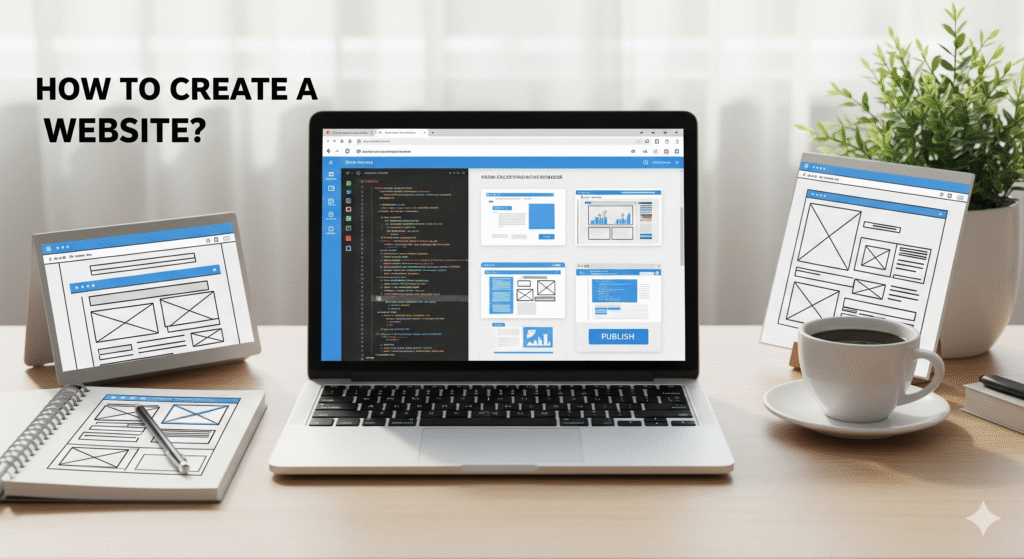How to Create a Website?

Creating a website has become easier than ever, thanks to modern tools and platforms. Whether you’re starting a blog, an e-commerce store, or a business website, this guide will walk you through the essential steps to build a fully functional website from scratch.
Step 1: Define Your Website’s Purpose and Goals
Before you start, clarify the purpose of your website. Ask yourself:
- Is it a personal blog, a business website, or an online store?
- Who is your target audience?
- What features do you need (e.g., contact form, online payments, galleries)?
Defining these goals helps in choosing the right platform and design.
Step 2: Choose a Domain Name and Hosting Provider
Domain Name
Your domain name is your website’s address (e.g., www.yourwebsite.com). Choose a name that is:
- Short and memorable
- Easy to spell
- Relevant to your brand or niche
You can register a domain with providers like Namecheap, GoDaddy, or Google Domains.
Hosting Provider
Web hosting stores your website files and makes them accessible online. Popular hosting providers include:
- Shared Hosting (Budget-friendly): Bluehost, Hostinger
- VPS Hosting (More control): SiteGround, InMotion Hosting
- Managed Hosting (Best for WordPress): Kinsta, WP Engine
Step 3: Choose a Website Building Platform
You can create a website using different platforms, depending on your technical skills and needs:
- WordPress (Most popular, flexible, SEO-friendly)
- Wix (Beginner-friendly, drag-and-drop builder)
- Shopify (Best for e-commerce websites)
- Custom Development (For advanced users using HTML, CSS, JavaScript, and frameworks like Laravel or React.js)
Step 4: Design Your Website
A good design enhances user experience and engagement. Key aspects to consider:
- Choose a Responsive Theme: Ensure your site looks good on all devices.
- Use a Simple Layout: Avoid clutter and keep navigation easy.
- Add Branding Elements: Use your logo, brand colors, and typography consistently.
Step 5: Add Essential Pages and Content
Your website should include key pages such as:
- Homepage – The first impression of your brand.
- About Us – Information about you or your company.
- Services/Products – Details about what you offer.
- Contact Page – Email, phone number, and location.
- Blog – (Optional) Great for SEO and content marketing.
Step 6: Optimize Your Website for SEO
Search Engine Optimization (SEO) improves your website’s visibility on Google. Key SEO practices include:
- Use Relevant Keywords: Research using tools like Google Keyword Planner.
- Optimize Images: Compress images for faster loading.
- Write Meta Titles & Descriptions: Helps search engines understand your content.
- Build Internal & External Links: Improves credibility and ranking.
- Ensure Fast Loading Speed: Use caching plugins and a Content Delivery Network (CDN).
Step 7: Test and Launch Your Website
Before going live, test your website to ensure:
- All links and buttons work correctly.
- It is mobile-friendly.
- There are no typos or grammatical errors.
- The site loads quickly.
Once everything is set, publish your website and announce it via social media or email marketing.
Step 8: Maintain and Update Your Website Regularly
A website requires regular updates for security and performance. Here’s what you should do:
- Update plugins and themes (if using WordPress).
- Backup your website regularly.
- Monitor performance using Google Analytics.
- Refresh content periodically to keep it relevant.
Conclusion
Building a website doesn’t have to be overwhelming. By following these steps, you can create a professional, functional, and SEO-friendly website. Whether you’re using WordPress, Shopify, or coding from scratch, the key is to plan well, focus on design, and optimize for search engines. Start today and bring your online presence to life!
Do you have any questions about website creation? Let us know in the comments!

